Fly agaric – Edibility, Identification, Detoxification, Medicinal Use
Amanita muscaria
- Edibility 3/5 – Toxic and hallucinogenic if consumed raw, but if correctly prepared, perfectly edible as food, with no ill or hallucinatory effects. When properly prepared, fly agaric is a decent edible mushroom – not in the top tier of delicious wild mushrooms, but a perfectly pleasant abundant and easily identified wild food. Please see my detailed notes and links on this below. Fly agaric tincture is also used by some herbalists in the topical treatment of sciatica.
- Identification 4/5 – Can be confused with red Russula species (esp. the sickener, Russula emetica) if scales are washed off. Free white gills, a substantial ring on the stipe and a bulbous, scaly volva. When very young and still covered by its universal veil, fly agaric can be hard to distinguish from other amanitas (including deadly poisonous amanitas) and resembles puffballs, and young agaricus species such as field mushrooms and horse mushrooms to untrained eyes. See my photos below for illustration. For taxonomy geeks only, recent advances in taxonomy and DNA sequencing mean that many mycologists now recognise 3 distinct morphological forms of the species: Eurasian, Eurasian “subalpine”, and North American (Amanita muscaria var, formosa which has a yellow or orange-yellow cap with yellowish warts, and a yellowish stem). Within these forms several distinct genetic variants are recognised: var. alba, var. flavivolvata, var. formosa (including var. guessowii), var. regalis and an albino variant var. alba). Those with a non-scientific interest needn’t worry about these distinctions.

Fly agaric at the button stage, still covered by its universal veil. Beyond the questioanble ethic of harvesting mushrooms before they have dropped any spores, extra care should be taken when identifying any immature fungi, particularly if they look like this. It could look very different a day later!
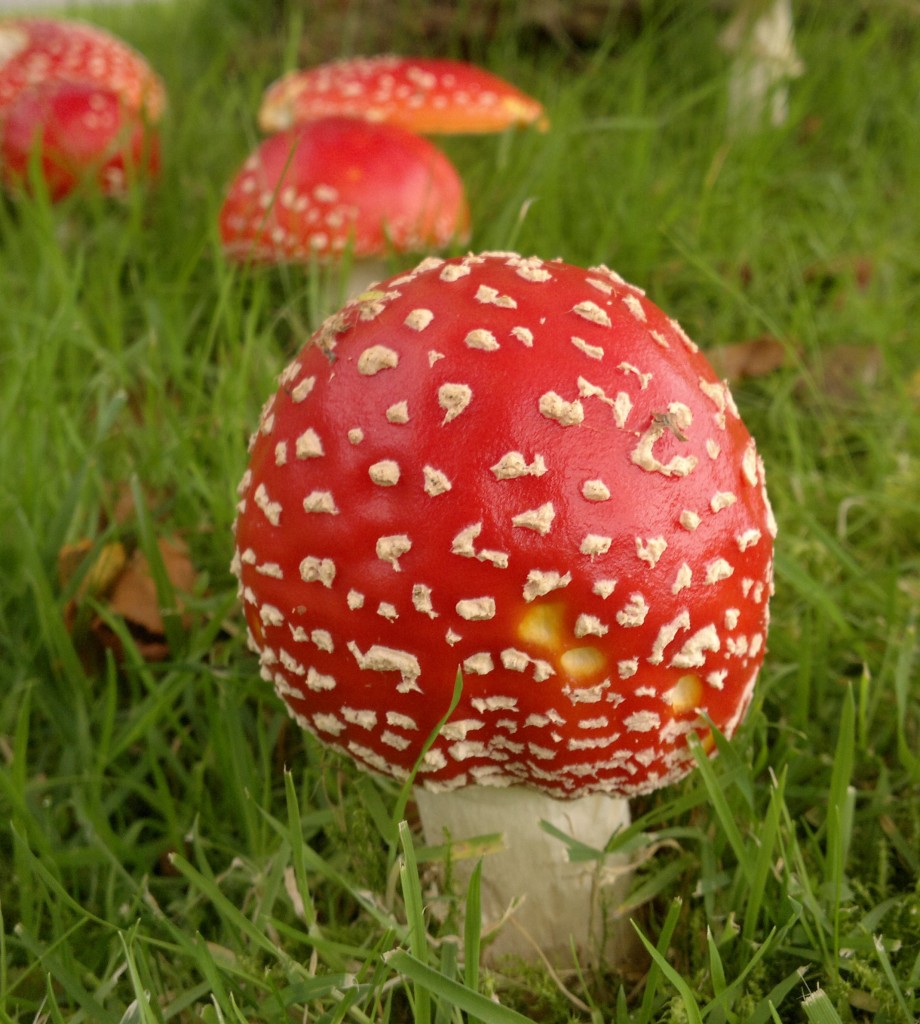
The broken up universal veil becomes the distinctive white spots of mature specimens. These can easily be washed off in wet weather.
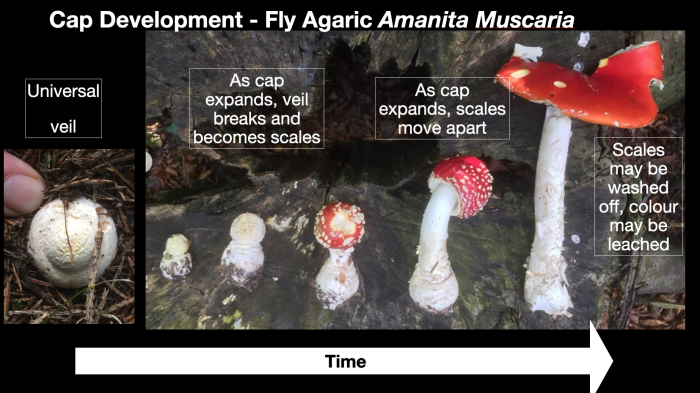
Growth of fly agaric over time. Time between stages depends on a variety of factors, but approximately 1 week between universal veil stage and fully open stage is typical. Image ©GallowayWildFoods.com – taken from my Webinar “Wild Mushroom Identification”. Click the image to view the webinar.
- Distribution 5/5 – Very common in its habitats across the UK, N Europe, N Asia and much of N America
- Season: July-November
- Habitat: Mostly growing with birch and (sitka) spruce in the UK, but also occasionally recorded with other conifers and oak.
- Ecological Role: Fly agaric is a mycorrhizal fungi, living in close symbiosis with its partner trees. Its mycelium mines water and minerals, which are traded with tree partners for simple sugars. Learn more about this here.
- Harvesting Notes: Fly agaric is generally abundant, and, if it could express a preference, would probably thank you for carrying a few of its spore-bearing caps, gills-down, in a basket, through the forest. Thanks to its iconic beauty, it is one of few mushrooms that is admired by the non fungi-literate, as they might admire a pretty flower, so its nice to leave plenty in public spots for people to enjoy. Hopefully they will capture their imagination and be a stepping stone into a wider appreciation of fungi!
- Legality: The legal status of fly agaric varies across the world. In the UK it is not illegal to possess it as it does not contain psilocin or psilocybin which are the controlled substances that make liberty caps ( aka magic mushrooms, Psilocybe semilanceata) and other Psilocybe species illegal.
- Relationship with other Fungi: Fly agarics are a good “signalling species” – tending to grow in the same locations as penny buns (aka cep, porcini, Boletus edulis). I sometimes abbreviate FLy AGaricS to “FL.AGS” for this reason. Their relationship with penny buns may be just a preference for the same mycorrhizal partners, but sometimes seems to be more complex than that, and requires further research. What is more clear from my personal experience is a complex interdependency between Fly agaric, the miller (Clitopilus prunulus) and peppery boletes (Chalciporus piperatus) and their tree partners. It has been known for some years that peppery boletes are parasitic on fly agaric mycelia, but I suspect there is more at play here: I almost alway find peppery boletes and the miller near penny buns, suggesting that they have a myco-myco relationship (inter-fungal trading? …or parasitism? …and if so, who is parasitising who!?). Although certainly a good indicator, fly agaric are less reliably present near penny buns. Who knows what complex battles, alliances and trades are going on beneath our feet!? It’s fun to muse and speculate on these relationships when out foraging – and as there is a dearth of research on the subject, nobody can poo-poo your elaborate theories!
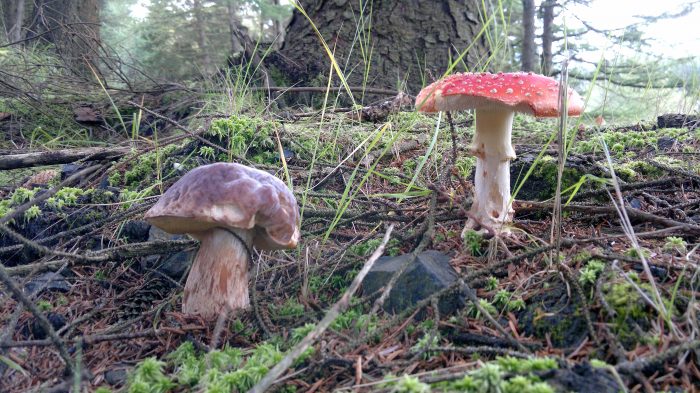
Fly agarics can be a bright red clue to the presence of penny buns (ceps)

Peppery bolete, Chalciporus piperatus, is known to be parasitic on the mycelium of fly agaric
Eating Fly Agaric as Food
The edibility of fly agaric is a somewhat controversial but really very fascinating subject, touching on cultural sensibilities, chemistry, legalities and our wider understanding of how we define “edible”.
There is a fair bit of reading to do to give yourself a balanced view and you should give consideration to both the following articles before you decide if eating fly agaric is for you.
On the one hand:
- Contrary to nearly all guide books, this mushroom is edible and tasty with no ill effects – BUT ONLY IF IT IS PROPERLY PREPARED. There is an ongoing cultural prejudice against eating it, as documented in this article which also includes directions for safe preparation.
While on the other hand:
- A.muscaria is a potentially VERY POISONOUS (occasionally deadly), only made safe to eat by meticulous preparation and generally not recommended as an edible mushroom. Please read this article which refutes many of the claims made in the article above.
You may then also wish to read my further thoughts in response to the second article in the comments section below, in which I discuss the issues with the author of the second paper.
My personal take is that eating any wild food (or indeed, any food) should be a matter of taking personal responsibility for what you choose to eat. This means doing enough research to feel comfortable in identification and consumption (ie. not just one paper or guidebook – and certainly not just one website!). There is no pleasure in eating anything new without feeling comfortable about what it is, what it contains (naturally or artificially), and how it interacts with personal tastes and tolerances.
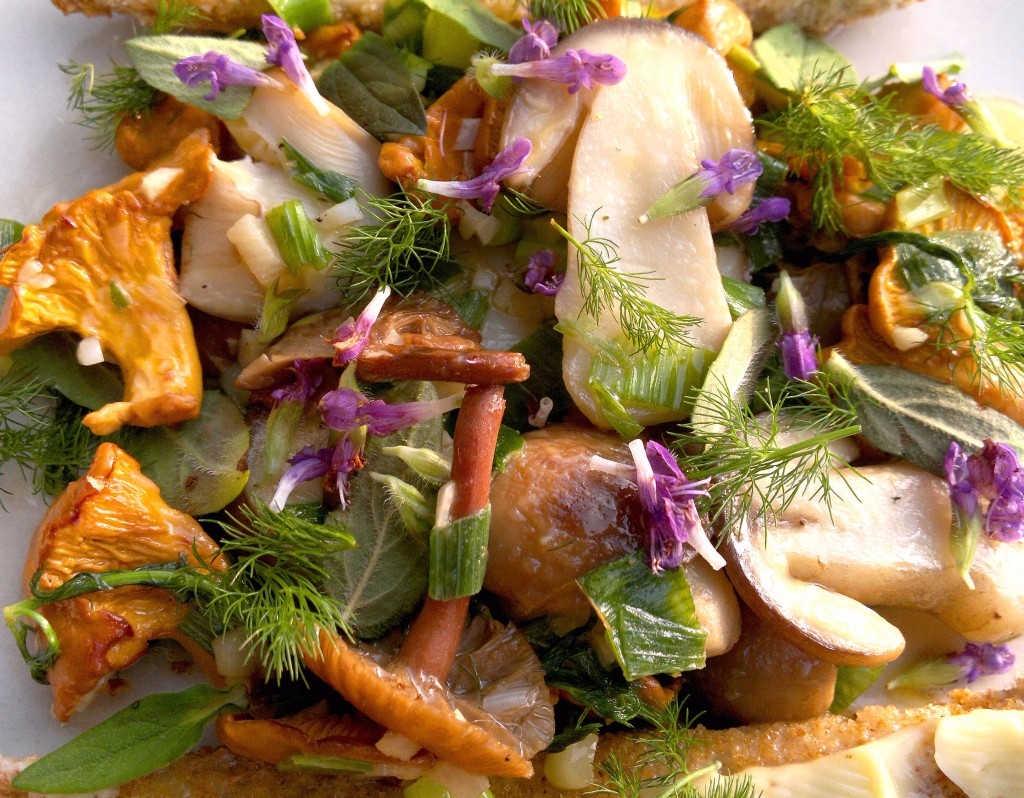
A delicious mixed dish of properly prepared fly agaric, blusher, deceivers and chanterelles with late summer herbs. ©GallowayWildFoods.com
Edibility is not black and white, but culturally and personally defined. “Poisonous” and “Delicious” are not polar opposites, but lie on what I call “The Spectrum of Edibility” – read more about this here: Blog – “The Day I Ate A Deadly Plant: The Spectrum of Edibility“.
So in summary, I am entirely happy to pick, carefully prepare and eat fly agaric as a food – but that doesn’t mean you should feel the same! I notice some foraging guides make a point of feeding ‘detoxified’ fly agaric to clients on their events. Personally I don’t – I think it is a process for individuals to research, consider and take personal responsibility for, and not something to be used as a trite gimmick or social media post.
Detoxification of Fly Agaric for use as Food
When I use fly agaric as food I tend to just roughly chop (quite thin), boil in plenty of salted water for up to 10 minutes, strain, rinse and then cook with them. I’ve never had any issue with this rather unscientific approach. But if you are going to try them for the first time, you’ll probably want the reassurance of a more prescriptive method. So I’ve adapted the steps below from the Rubel & Arora paper discussed above.
Perhaps you are wondering whether the mushrooms will still be worth eating after a long boiling like this. They are. Unlike vegetables, which tend to go mushy when boiled, the cell structure of mushrooms is such that they keep their form and much of their texture when cooked for longer periods. In many European mycophillic countries, most mushroom prep begins with boiling – I will never forget the look of horror among a group of Ukranians when, after our mushroom foray, I just started frying chanterelles! Mushrooms hold up well to boiling because their cell walls are composed of chitin (pronounced Kai-tin), the same substance (though in slightly different form) as shellfish carapaces are made of. Chitin is also the reason why a high proportion of fungi can be challenging for humans to digest, as we lack the correct gut enzymes to break it down fully, which, interestingly, is a significant factor in why some of them are so good for us – but i’ll save that for another blog!
Method for Detoxifying Fly Agaric to use as Food
1. Slice clean specimens (cap and stem) into pieces up to 5mm thick. Note: If you cut them thicker, increase the boil time.
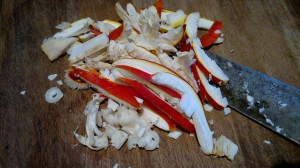
2. Weigh the chopped mushrooms. For every 110g of mushroom, measure 1 litre of water and 1 teaspoon of salt into a pan. Bring to a rolling boil. Note: Salt helps to extract the water soluble components. You can add flavourings like bay leaves, peppercorns etc here too if you wish.
3. Add the chopped mushrooms to the boiling salted water and start a timer once the water returns to the boil. Time 10 minutes (or 15 minutes if you are particularly nervous!)
4. Strain the mushrooms. Note: The strained liquid now contains the active ingredients: they are not destroyed by the boiling process. The broth will go off if stored for more than a couple of days.
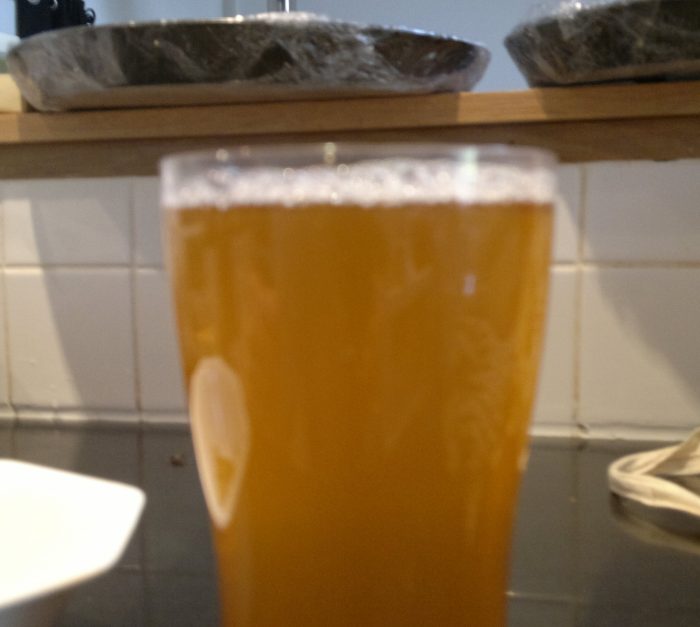
Fly agaric “stock” – looks quite like beer!
5. Rinse the boiled mushrooms in plenty of fresh water and strain.
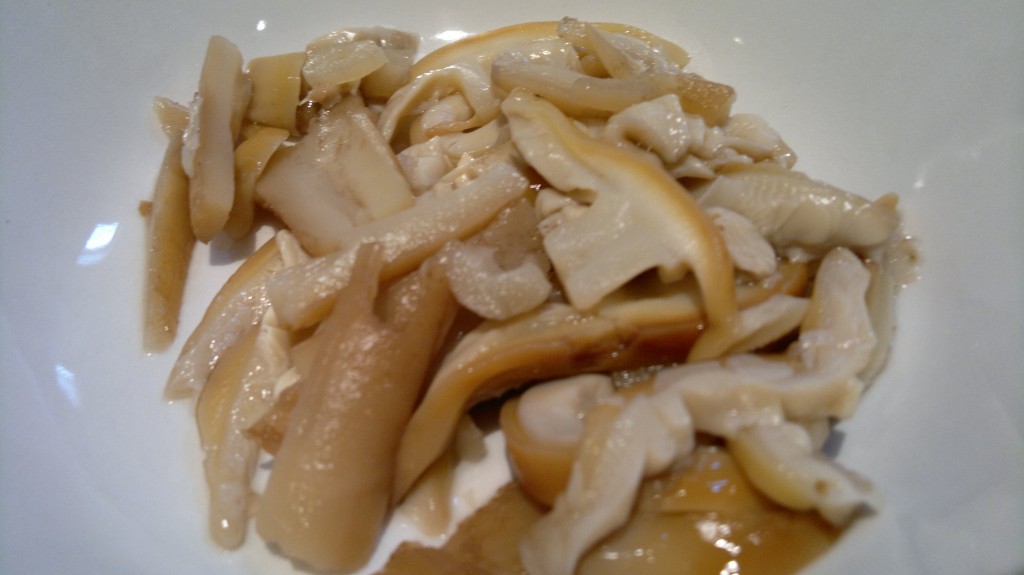
Fly agaric after boiling & straining
6. You can now use the fly agaric as you would any other mushroom.
Note: Foraging teacher Fergus Drennan has reported that after dehydrating correctly detoxified fly agaric, some of which he ate with no issues at all, he experienced mild intoxication when he reconstituted and used the same dehydrated mushrooms in a risotto. It seems that any vestiges of muscimol may be re-concentrated by dehydration, so care should be exercised if you dehydrate detoxified fly agaric. If you want to be very, very belt and braces with the initial detoxification process, Fergus also suggests baking in the oven for 1hr at 220º – which will remove all possibility of even traces of muscimol/ibutenic acid.
Eating fly agaric as a hallucinogen
Putting eating ‘detoxified’ fly agaric aside, if eaten raw (or if you drink the post-cooking broth), your body will have to deal with a cocktail of active compounds. Upon ingestion, muscimol and ibotenic acid can cause nausea and stupification (which can be seriously unpleasant, though seldom life-threatening). Usually after that (maybe an hour or so) come hallucinations, vivid visual disturbances and occasionally feelings of hugely exaggerated movements whereby the intoxicated person may take a huge leap to step over a small twig (and feel like they have jumped over a hill). It seems that muscimol is the principal psychoactive constituent of fly agaric, causing sedation and delirium, while ibotenic acid acts as a prodrug to the muscimol – ie. helping to increase its bio-availability. Drying reduces, but does not remove, its potency. As with all drugs, dosage and personal tolerance are all important to the physiological response, and mindset and setting can strongly influence the psychedelic/psychological outcomes. This is not a drug to take lightly.
The potency of the active ingredients in fly agaric can depend on when you pick it. First flush FlAgs (which tend to appear between July and August in SW Scotland where I am based) tend to be much more potent than later ones. Also significant is the stage of growth at which it is picked – generally, the younger and more intense the red, the more potent. And there is also the matter of personal tolerances.
I have recently heard positive reports on the use of very small doses of fly agaric (not detoxified) in the treatment of anxiety, though there is currently no significant scientific research or clinical trials to underpin this.
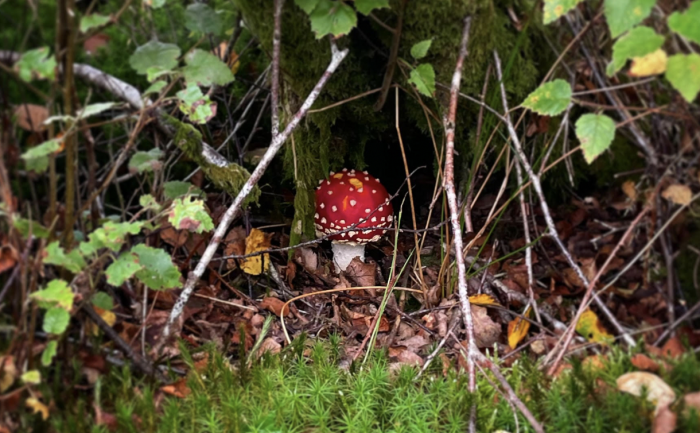
When we find fly agaric on my guided walks we stop and marvel at their extraordinary beauty before exchanging all the well known fly agaric stories of pee drinking, flying reindeer, berserkers etc. No mushroom captures the imagination quite like the fly agaric! Its not surprising that was the first mushroom to have its own emoji!
🍄🍄🍄🍄🍄🍄🍄🍄🍄

Fly Agaric Gaze, original linocut print by Alice Aries Artworks
Please share your tales, myths and experiences in the comments box below.
Further reading:

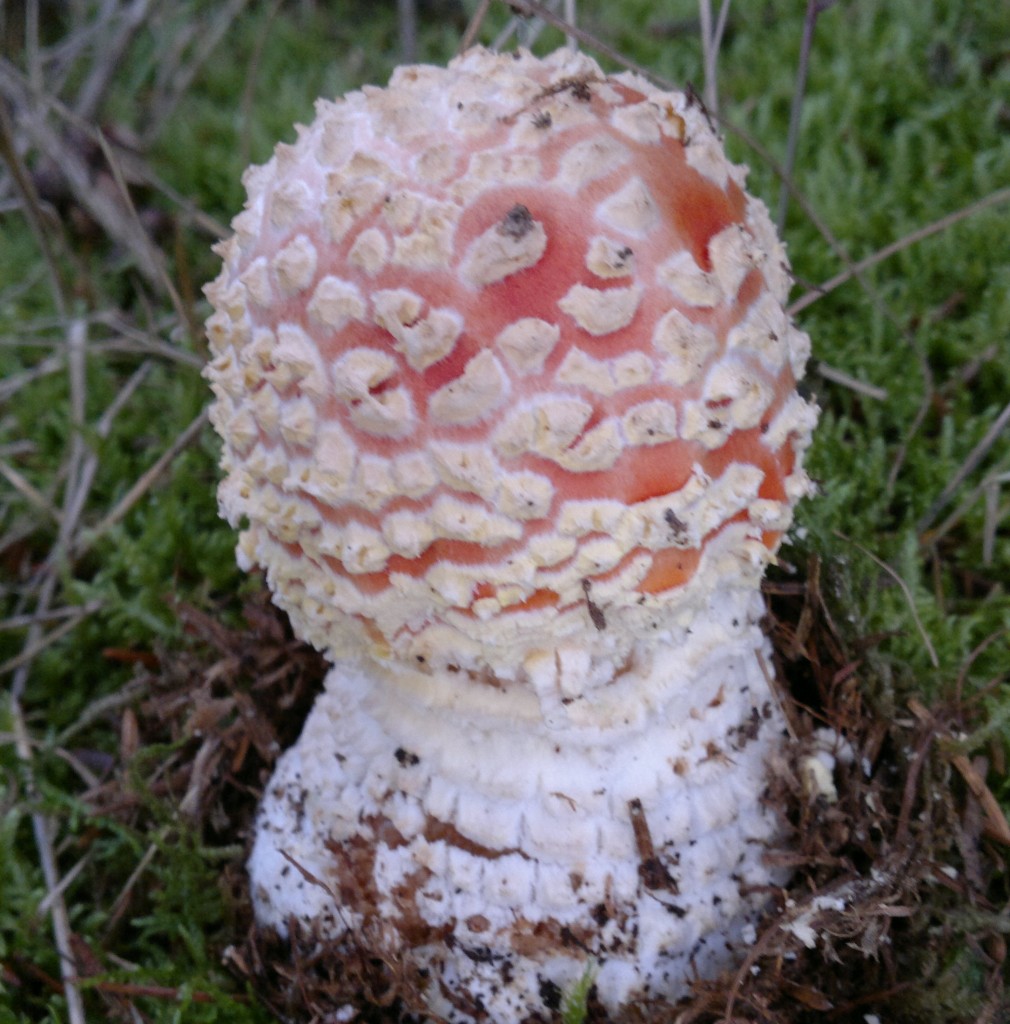
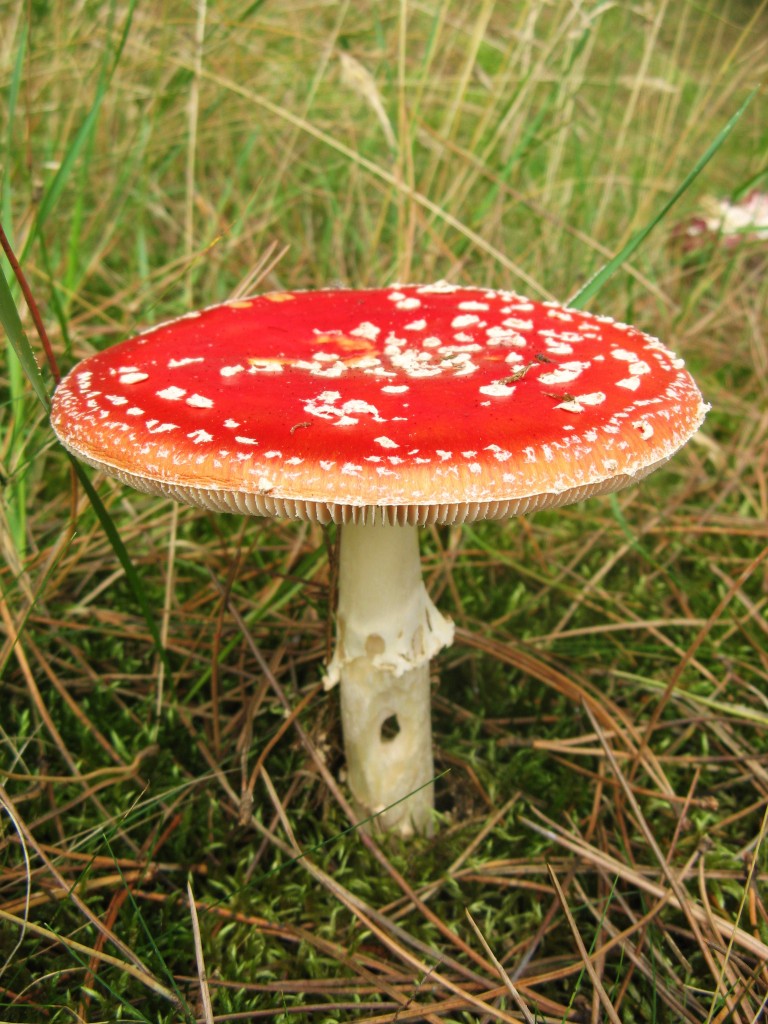
61 Comments
Hi Mark,
A very interesting article on fly agaric, these fungi were abundant in Arrans birch woods but i always avoided them when out on fungal forays. I have a field guide advising that L.sulphureus is not edible, and we all know thats nonsense too.
Hi,
I have recently published a lengthy rebuttal to the ill-conceived Rubel/Arora piece on the edibility of Amanita muscaria. Suffice it to say that it is actually good common sense rather than some sort of nebulous “field guide bias”
that has caused folks around the world to eschew muscaria as an edible species, except in rare circumstances. Nowhere is muscaria eating common or generally accepted by the fungiphilic majority, either now or in the past.
To read the whole truth about the consumption of this controversial, highly toxic and yet fascinating species of fungus, go here:
http://mushroomthejournal.com/bestof/muscaria_revisited.pdf
Yours in mycological truth and justice,
Debbie Vies
Bay Area Mycological Society
http://www.bayareamushrooms.org
Hi Debbie,
Thanks for this excellent article. I read it with great interest and it certainly diminished my appreciation of the Arora/Rubels paper. Nevertheless, I think I presented the information here in a sensible way which allows readers to make their own minds up on this matter – though I will add some prominence to your article to present a balanced view and outline the shortcomings of the “pro-muscaria eating” paper.
This is in line with the general principle I teach with regard to eating any wild food (plant, shellfish, marine algae or fungi) – that of taking personal responsibility for what we choose to eat. This includes making well informed judgements with regard to identification, edibility (ie. check multiple sources), personal tolerances, the variable nature of the composition of wild ingredients, bio-accumulation of pollution and so on…
I think the more balanced summaries of the edibility of A.muscaria that you detail towards the end of the report are the way forward for listing this species.
I have a few observations that may be of interest to your ongoing research:
– I eat a.muscaria a few times per year as food. I personally do not follow the explicit detoxification “recipe” given in the paper. I just use a lot of salted water, a generous (though again, unmeasured) boil time and plenty of rinsing. I do not advocate this approach to people trying it for the first time, but I feel entirely comfortable with this. Were I intending to feed it to others, I would be more meticulous. I like the flavour/texture when seared afterwards, though its certainly not on the top gastronomic tier!
– I do not feed it to people on my fungi walks. I think this is something to do for ones self without bravado or peer pressure and with due contemplation – not least for the peace of mind and sense of personal responsibility it fosters. I do, however, regularly graze yew berries with my groups, reminding them to spit out the highly toxic (if unlikely to be broken down by digestion) pips. I call it wild food fugu and people enjoy the experience. Its interesting to note that people will easily take to eating yew berry flesh, but very few would consider detoxifying a.muscaria or a.rubescens. Mycophobia is deep set.
-A.muscaria is one of our most common mushrooms and pretty much the easiest to identify. This, in an odd way, makes it an excellent “beginners” mushroom. In many ways I think it would be far better for people to mindfully pick and reverentially prepare a.muscaria than rare, over-harvested or “dangerous lookalike” species.
– There is certainly a prejudice against giving accurate information on a.muscaria in many guidebooks compared to other fungi that require detoxification. I’m aware that raw a.rubescens doesn’t present the same dangers as a.muscaria, but it should be prepared similarly. ALL my guidebooks list it as edible. See also morchella spp, armillaria spp,and many other fungi – as well as potatoes!
– People eat too little of, too much of, badly prepared, under-ripe, over-ripe, undercooked, overcooked or just plain daft things all the time. I think we could choose just about any foodstuff (established or “cutting edge”) and find examples of it making people ill or killing them.
– My friend Miles Irving, a respected writer on edible wild plants and supplier of wild foods to many of the UK’s best chefs, served a.muscaria at a banquet for (if memory serves) 300 people last year. All were “knowing participants” and I heard no reports of any ill-effects. I don’t know the details – I don’t imagine he served them much – but you might wish to add his observations to your research (http://www.forager.org.uk/)
– I find about 1 in 200 people have an adverse reaction to eating well-cooked c.cibarius!
Thanks again for your illuminating research and please do forward me anything similar in the future.
Mycologically yours,
Mark.
I have eaten Amanita Muscaria for many years my doctors do 3 blood tests for liver function and any other issues that may be present and like I suspected no ill effects . In the early 80s I picked a whole brown paper bag full of giromitra ( false morels )what we called German browns , I ate the whole bag fried with onions upta camp . No mushroom in my opinion should be cooked while covered, I was hospitalized for one night and day , false morels cooked with a cover may make you very ill but I’m still kicking. I would not eat a destroying angel ever . Sam ristrich was involved in studying me for his research at the university. Some folks may be different but I’ve eaten aminita muscaria raw , cooked , and as a tea for years but I don’t drink urin lol .
thats a trip
i was bent double….punching a wall….for 2 hours from pain…..on a regular liberty looking shroom. but…..not hospitalized. but i was sick sick sick …very sick….twice..on shrooms
and..I am drying out about 5 handfulls of caps right now in Denver….in the park !
Hi Mark
Thanks for you comments above.
If eaten after being cooked or as a tea etc. Do the psychoactive effects still remain ?
I have been on anti depressants for years but have now stopped and micro dose certain mushrooms for the medical help they give ( I must say with very good/ and positive mental health benefits).
Thank you for your time
DM
Hi David, I’m glad you are having positive benefits. It might be worth you re-reading my the info above as I think it answers your question. Basically all the psychoactive compounds are water soluble, so they do not remain if they are prepared as detailed above. They would be present if you infused into tea.
Mark.
Hi I came on here to look for how often I can use fly a Garrick topically. I made some with the help of a friend who’s been using it topically over her SI joint for seven or eight years and my back got thrown out last week and I’ve just been absolutely beyond miserable. I’ve taken pain meds at the maximum dose and I’m in just so much pain so I pulled out the flyer Garrick to see if it would help and within seconds the pain went down to 33% of what it was. It lasted probably over an hour I didn’t look at the time it was around 5:00 or 5:30 p.m. here and it was just about 7:00 p.m. when the pain started coming back. And I would really like to use it again. Is there any particular writings that say how often is too much to use?
Sorry, I don’t know. Perhaps check the linked article, or with a trained herbalist?
Mark
I love hearing stories about fly agaric; reindeer urine drinking, santa clause being a remnant from pagan shamanism, viking berserkers, etc, and as a Norwegian I can add a personal relic to these stories. Lying amongst potluck dinner casserole dishes, Lutheran Bibles, and other wholesome midwestern family heirlooms is a fly agaric candle holder! This is well over 100 years old, who knows if the makers of the object new the significance of the mushroom, or were just using a carried over symbol that lost its true meaning but I do know one thing, if you go back far enough my ancestors were using this mushroom and I have the relic to prove it! Great article, even though this type of mushroom is WAY advanced for a beginner like me, I love learning more about it. BTW I can send a picture if you want.
Hi Trevor,
That’s really interesting – i’d love to see a picture of the candle holder.
This is such an iconic mushroom that it has pervaded human consciousness in many way – often regardless of it psychoactive nature.
The main thing for me is that it is really, really beautiful – and always a delight to stumble across.
Happy foraging,
Mark.
Hi Mark,
I appreciate your highlighting some of the ideas presented in my paper for your blog readers. I agree with you that, as individuals, we can choose what risks we want to take, and what we choose to put into our own mouths, for whatever reason.
I took exception to Rubel and Arora downplaying the very real dangers of eating muscaria, and their claims that it was commonly eaten or was a widely accepted edible anywhere or at any time. This is simply not true.
Yes, one can boil it enough to remove at least most of the toxins; the longer the prep, though, the more likely to remove them all. Try that well-boiled piece, though, and it is not so delicious anymore. Carmelizing anything in butter improves its flavor. Why drop a toxic mushroom into the mix?
A number of folks who are experienced mycophagists have had unpleasant poisonings when using a boiling prep, so it is certainly not foolproof, even when the cooks are far from fools.
Beginning foragers are well served by initial warnings about any toxic species; let the experimentation come later, with experience. Morels are a poor comparison to muscaria; morels are not toxic once cooked; no special cooking whatsoever is necessary. With “edible” muscaria, there are lots of caveats: thin slices, just enough water, double boilings and don’t forget to throw out that boiling water when you are done!
Not quite the same as just throw it in a pan and cook and done.
Some folks enjoy that “fugu” experience, and more power to ’em. but that’s a long way from touting muscaria as a safe and unremarkable edible species in any future field guides.
As to your UK chef friend serving muscaria to the masses: all toxins are dose dependent. As I stated in my paper, i have eaten muscaria three times: once parboiled and sautéed (yucky), once just grilled (yummy!) and once rehydrated on pizza. Even the unboiled muscaria had zero effect on me, positive or negative, but that doesn’t mean that I would serve it to others, or consider it to be safe. One piece, no matter how prepared, is a meaningless dose, for most. These muscaria tastings are not controlled scientific studies, they are foodie thrill seeking. One slice of muscaria is harmless to most, boiled or unboiled; escaping unscathed is hardly news.
The danger is when folks take away the idea that muscaria is a harmless mushroom, easy to ID and prepare. If that were so, it wouldn’t be universally shunned by fungiphilic cultures everywhere. Yes, there are small pockets of those who have learned how to prepare it, but they are the exceptions not the rule, and in most cases there are extenuating circumstances (i.e. starvation).
The current muscaria fad is something else again. When enough people get poisoned, then that pendulum will swing back the other way.
You are absolutely right about the almost universal fascination for this beautiful mushroom, and the very discussion of eating this highly storied mushroom is plenty of thrill for most. This is exactly why I believe that it has been mentioned here and there throughout history: it’s a hot topic.
I certainly wouldn’t recommend a toxic mushroom for the table just because most of the time it is easy to identify. Use that knowledge to avoid it for the table, not embrace it. But that’s just common sense.
Your philosophy may vary.
Thanks for reading,
Debbie Vies
I agree totally with everything you say. A dear friend of mine was given a tincture made out off fly Amanita muscaria and vodka. She only dabbed it on to her flesh were old scars were. When going to bed she felt fine, then awoke in a psychotic episode that has continued now for 7 weeks. Ibotenic acid poisoning interferes with your Gabba A transmitter pathways. When dabbing it on her skin it went through the most permeable part of her skin straight into the blood and through the blood-brain barrier dear friend is not the same. You may say this is a rare case but Beware! Beware! Be aware.
You appear to be saying that it is fine to eat, say, one whole fly agaric mushroom or one slice of a whopper) and that the bad press is due to excessive consumption – say, 2 or more mushrooms – which sounds plain dumb anyway. If we allowed gross stupidity to rule our lives there’s no telling what would happen…oh we do already! p.s. I gave my cat a teaspoon of amanita muscaria and he was missing for…3 minutes.
Fly Agarics are not illegal to pick and gather.
The Fly agaric does not contain psilocin or Psilocybin, both of which are illegal in the UK.
If you are in the UK then you live by UK laws, forget what other contries do, or the legality of Fly Agarics in those countries, we live in the UK and live by those laws.
Mushrooms that do contain psilocin or Psilocybin are illegal such as “Psilocybe Semilanceata” AKA “Liberty Caps” Britain’s most popular “Magic Mushroom”!
Fly Agaric (Amanita Muscaria) may not be sold for “Human” Consumption, that is illegal.
However it is not illegal to pick, dry or posses Fly Agaric nor is it illegal to consume those which you have picked and dried yourself.
Fly Agarics can be processed by removing the “Ibotenic Acid and Muscimol” into an edible food stuff, there are methods on the internet that will show you how!
By thorough drying the Ibotentic Acid is converted in to Muscimol.
Ibotenic Acid is what gives you stomach cramps and Muscimol is more psychoactive, so proper drying of the cap is best if you wish to consume them.
Muscimol is 5 times as psychoactive than ibotenic acid and much gentler on the stomach.
Dosage guides can be found on the internet with a bit of searching.
Crumbling the caps into milk is a traditional way of catching flies as it make the sleepy and easier to kill.
Never pick or consume any mushrooms or fungi unless you have a good knowledge pf them and can positively identify the target species you wish to pick.
Beginners are advised to go on a guided fungal foray with a mushroom master, there are many courses around the UK.
Great Info Bob, Thanks
Hi I don’t mean to ask foolish questions but I’ve found a group of these muscaria but they aren’t red they have a yellow cap with a bright red center it has the white spores but it doesn’t match any of the pics. I’ve seen is this still safe to ingest if prepared properly?
The colour in a.muscaria is (like the toxins) water-soluble. After wet periods they can often look orange or even yellow. The deeper red centre suggests that this i what has happened. At this stage they are likely to be well past their best for preparing for eating.
There is also a yelow form of fly agaric – Amanita muscaria var formosa. It has a yellow or orange-yellow cap with yellowish warts, and a yellowish stem. Native to N America, not sure if its present in Europe. I am not familiar with it, so would hesitate to give advice. My expectation would be that it can be treated in the same way as its more common relative.
Mark
Hi Mark,
Just found a yellow one newly emerging in D&G!
Not sure how to add a photo.
Oh shoot I was told that you can put a few drops on your skin and have no problems whatsoever and I put a dipped q-tip in my flag Eric and rubbed it over my SI joint area. A couple hours ago it took the pain away and helped immensely. I came on here to find out how often you can use it as the pain has come back. But now after reading this that does provide some concern. I hope somebody’s able to get back to me I think I’ll hold off taking any more tonight
Try Reading:
Amanita Muscaria: Herb Of Immortality, By Don Teeter, it is free to download from AmbrosiaSociety.org
I found a bunch of these mushrooms in 7/3/205 in
south Dakota’s Custer state park. I left them alone for not knowing what they were. I do not see how to attach a photo for conformation. if you email me at mm3ss678@gmail I will send you a couple of of jpeg pics the one I am looking at right is showing 8.87 MB I have 7 photos all ovver 8 Mb for each one.
Thank You,
Jackson Shinn
Hi Jackson, if you post them on my FB page i’ll try to have a look.
Mark.
In Led Zepplins “The song remains the same” isn’t this the culprit that sends Jimmy on a wild ride? Do you recommend that?
I’ve heard that the film includes a fantasy scene in which he eats some, but not heard any reports that it was responsible for their output! I can’t recommend taking class A drugs on a public forum. Best to read as much information as possible and make an informed decision for yourself.
Cheers, be safe,
Mark.
This is a fantastic piece, thanks for writing it. I wasn’t aware of the detoxification process for this mushroom to make it safe to consume, thanks for detailing it out.
My son picked and ate them washed peeled sliced and fried in butter with salt and pepper. They smelled delicious. I’m not a great fan of edible mushrooms any way but he ate 3 caps and had no ill effects. Not even a hallucination or purge. He said he would happily eat them again because they had a rich meaty flavour. The place we picked them was in the countryside near Carluke in a small open copice of trees. And the month was September. He has also eaten yew berries in the way described above. I would be more wary of yew berries than amanita muscaria.
That’s interesting Anne, but not something i’d recommend. The toxins are water soluble, but need rinsed away. Cooking alone is not guaranteed to break it down.
I have foraged mushrooms before, edible, and magick. Once someone i was with, told me a way to enjoy fly agaric without the dissapointment or poison…so i tried. Paling off the jelly top parts off, especially where a bug has nibbled, about a pea size when rolled up in your fingers. The rest of the walk was boingy, light, colourful and happy…..not sure of any of the science behind that, but never did it again, lovely little thing of beauty, even if just to appreciate visually …
Wow I need to get out more, I have only seen this type in books and cartoons and just assumed it was a myth like unicorns or leprechauns – I’m amazed that these spotted red things actually do exist!
You should know ‘Alice’ lol
I was bicycling down a trail in the Marin County Headlands, a national park in Northern California in October a week or so after a big storm and saw one growing under some trees, my first and I was thrilled. So I got off my bike, climbed 20 steps up the hillside and went down the other side and found a row of half a dozen of them. Beautiful. I see a couple of them there every week when it’s raining. And right now have a large one I collected yesterday in the fridge which I’m about to boil a couple of times and then fry for lunch. It will be my third wild mushroom meal, after blewits and white coral fungus.
Wow, now this is interesting. Some years ago, I tried the fly agaric, frying it up with some garlic, just a little to start with… then a little more… I think I ended up eating one medium-sized cap. I had no ill effects, but I was rather disappointed to find I had no hallucinogenic ones, either.
Glad to have found your site, you have inspired me to continue my experiments with this.
I ate one and it was very small and red with white spots i bouled it and felt nothing. Stupid.
Amanita in alternative medicine for arthritis and other disease treatments
https://amanitamuscariashop.com/how-amanita-muscaria-can-help-cure-arthritis-radiculitis-rheumatism-paralysis/
Hi there folks, just putting my ten penny worth in here .
Im 56, been foraging since 11/12 years old have eaten so many wild products, some with ill effects but nothing wild has made me as ill as eating a bit of off chicken from a supermarket. Not fly Agaric, not Magic mushrooms of which i have taken several types. As long as you educate yourself enough to be sure about what your imbibing you will have no probs ,,, theres also many apps now that will identify your fungi.
Even if your looking for a psychedelic experience there is enough info out there to remove any risk of death to yourself. Mushrooms and Fungi have been used for food and shamanistic ritual for 100s if not 1000s of years, even science is starting to embrace the medicinal properties of some hallucinogenic shrooms for the treatment of depression. So hail the humble fungi hail mama nature she will produce all that we need if nurtured and made able.
Thanks Andy, I agree with much of what you say here. Though there are obviously some issues about promoting the use of class A drugs on a public forum/business, which is why I don’t write much about it here. I’ve written bout the Spectrum of Edibility here: http://www.gallowaywildfoods.com/the-day-i-ate-a-deadly-plant-the-spectrum-of-edibility/
I’m pretty circumspect about using apps to identify any potential wild food, especially fungi – discussed in my book review/resources page here: http://www.gallowaywildfoods.com/foraging-guide-books-and-other-resources/
P.S. only just found this site I know Galloway well my folks live in Stranraer, just want to say how well put together it is, informative and myth busting refreshing and honest 🙂
Thanks Andy, glad you like it! 🙂
I saw a couple at a roadside overlook on my way to Nenana Hotsprings Alaska. I posted a couple pics on my facebook page. They were beautiful and a treat to see as i live in Fl and there are none in southern us.
can i eat them once there washed no cooking and how many.Thanks
Please read the information provided in the post.
I was at a stand in the local museum showing the public a seasonal collection of Mushrooms a few years ago. One Russian lady came up to me and asked about edibility and I gave her a rundown of some of the samples ending with various Amanitas. She then went on to tell me that she had eaten most of them (Presumably not A.Phalloides or A.Virosa) by simmering and changing the water a couple of times – something I had heard of as rendering A.Rubescens safe to eat. I got the distinct idea that Russians will eat any mushroom and blame the resulting liver damage on Vodka.
This is a fascinating and informative post. So controversial, I love it! Thanks so much for sharing Mark.
I read you and a watched a couple of videos and finally picked and prepared a big red fly agaric off the hillside a couple of weeks ago. Fried it in olive oil with salt and pepper after boiling it once for 15 minutes. It was delicious. Picked three yesterday and again prepared them the same way last night. Have eaten them all and I say they are very edible. Tastier than button mushrooms and have a meaty texture. It reminds me of traditional pokeweed preparation methods. Thousands of people eat and have always eaten pokeweed but there you need to boil it several times. Fly agaric just needs a little extra preparation time.
Thank you for the great website. I love looking for wild mushrooms, but have only felt comfortable eating chanterelles and pearl oysters as I felt 100% certain of their identification and edibility. Your approach (of caution, research with varied sources, common sense, but also not letting fear-born-of-tradition control ones choices) is one I will try to incorporate in all of my adventuring. Thank you for the circumspect viewpoint.
Fly agaric are NOT toxic, It was a classic popeye/spinach case,
Somebody put the decimal point two places to the left.
making it appear that they contained 10,000 times more .
they dont even kill flies, the flies just get really high and have a bit of a lie down.
Ref: Phamacotheon by J. Ott.
Ooops that should read two places to the right
I boiled a small one for a few minutes -not in salt then fried it , I didnt remove the red peel , iIt was delicious . But Later I was lying in my tent , It was like watching a movie in 3d for a few hours. Like highly amplified hypnogogic imagery . I dont remember any side effects.
Now that was an incredibly well written very informative explanation, and I absolutely agree with you. I mean, science is science, right? If the compounds are water soluble, they are water soluble, and if you are afraid, then just go and drink some Coca-Cola, if that is safe for you; but people should not push their fears and personal ideas on other people. To each, his own!
With admiration,
Pablo Lintz
Fly agaric is not a class A drug.
Basically, The Misuse of Drugs Act reclassified mushrooms containing psilocybin or psilocin as Class A drugs. But fly agarics do not contain these chemicals. This means that you can possess them without any consequences. It’s still illegal to sell fly agaric for human consumption though.
This is covered in the post, not sure why you are repeating it here.
Having magically stumbled upon for the second time beautiful red topped mushrooms with white spots, this time I decided to bring some home.
I’ve read so many articles, some suggestions are to boil the mushrooms three times in salted water and then cook them ? Another says to boil them for ten minutes and then cook..I’m at a loss..I do not want to loose all of their majic qualities and then them to nothing..
Any advice anyone please ?
Hi Angela, Hopefully there is sufficient advice on this page! The linked article provides clear, safe and accurate information on how to prepare them as food. Due to the composition of mushroom cells, pre boiling as advised does not turn the mushroom to mush. It can be fried etc after the detox process. If you are looking to use their psychoactive properties, you should not cook them.
Mark.
My first year of foraging AM. Last batch I was drying out in the oven with a thermometer at 72c while preparing supper. Previously the condensation inside the oven meant liquid dripping out of the oven door so this time I intermittently ‘burped’ the oven, opening the door to let out the vapour for the extractor fan to blow outside. In the process of doing this I inhaled some of the vapours. After supper I was high as a kite, a body feel similar to MDMA/THC/Coke etc. It was very pleasant! I wondered if it was therefore worth, next year, condensing the vapour? What was causing this pleasant effect, ibotenic acid, muscimol, muscarine? Also wondering, if I inhale the vapours when boiling dried AM will this give a similar effect? Has anyone tried this?
What would be the best detox process for using muscaria as a sleep aid? If dried completely, the Muscimol could be non-existent, possibly defeating the endeavor. I have tried muscaria in the past, and it worked for restful sleep for 3 consecutive nights, but I do not remember exactly the process I used and cannot retrieve the article that gave me the recipe. They’re up now and I want to get it right!
Hi Mark, brilliant read. Like Barbara Hanson I too would like to know how to use them as a sleep aid?? I’ve suffered for 36yrs with delayed sleep phase syndrome (severe insomnia) I’m awake all night till 7am then have broken sleep over 4hrs. I was told taken in micro doses it is really good for insomnia & depression.
I have 8 large ones that I picked at 6am this morning.
I’m thinking dehydrating in my air fryer would be best as they might go off boiled if not eaten within a few days?
I’m a complete novice so really have no idea?? Ive just read a few articles like your own . I would gladly send you a photo if you like. I live in Leicestershire. A local wildlife group posted a photo of them about 80 altogether. I picked about 8 so plenty left for others
Hi Patsy, Sorry, but I am not a medical herbal/mycologist so do not advise on things like this. I can recommend “Medicinal Mushrooms” by Martin Powel as good, well referenced book on the uses of medicinal mushrooms, but it doesn’t include the use of fly agaric.
Mark
Thanks for a great read & for your expertise in wild mushrooms
Thank you Mark for such a fascinating and informative article!! And also thanks to all for their helpful comments.
Excited to pick some in my Canadian woodland home!